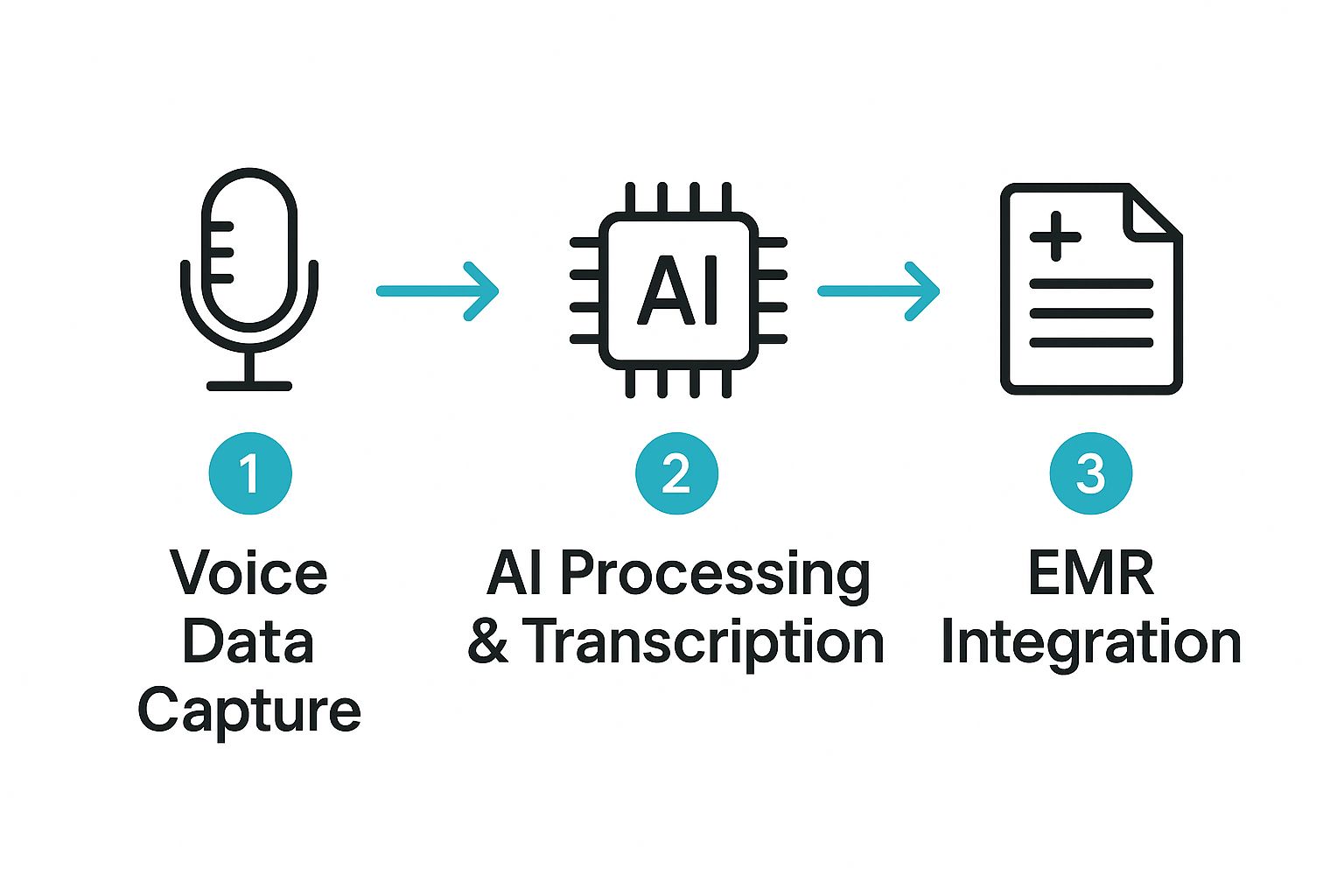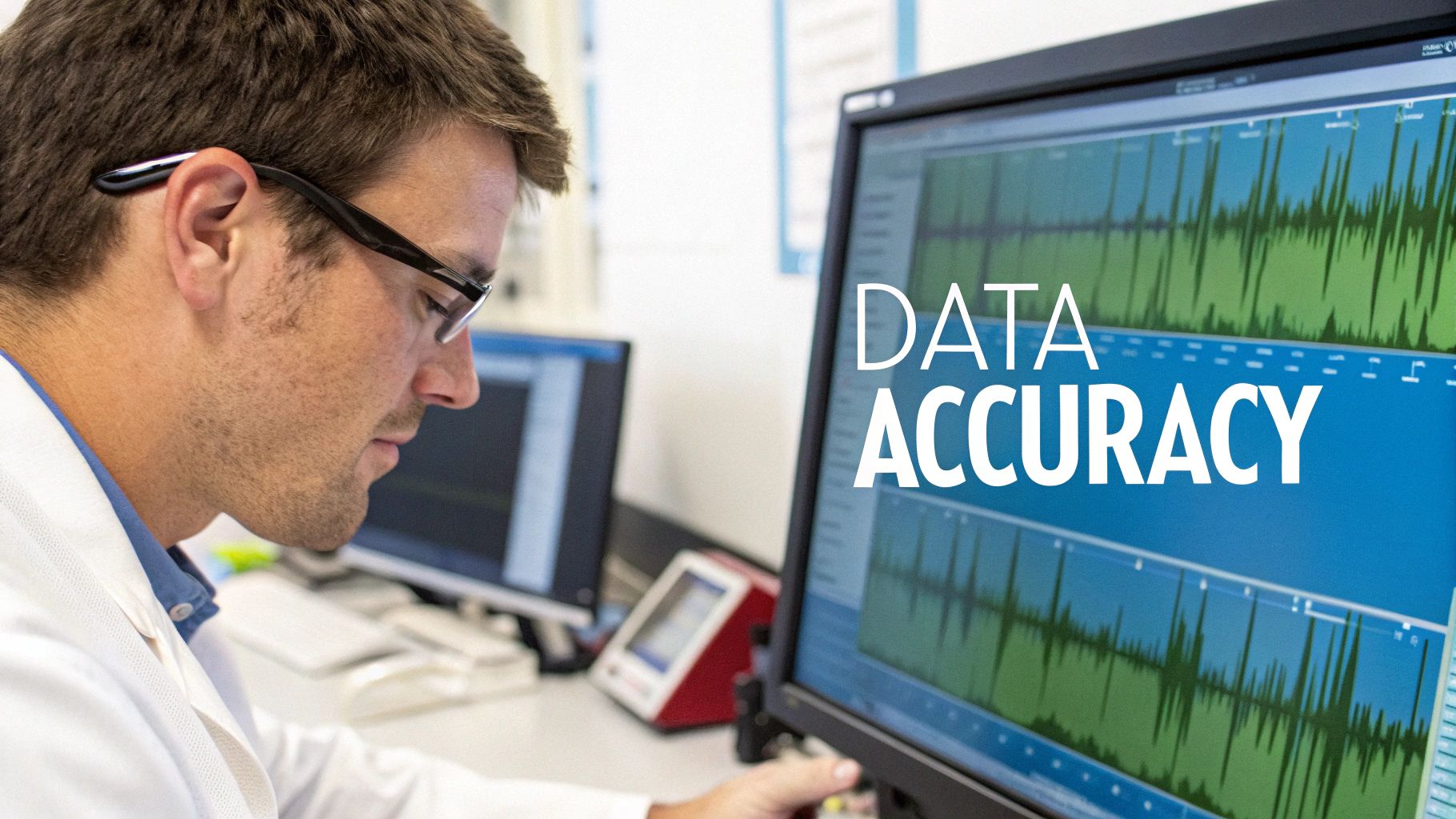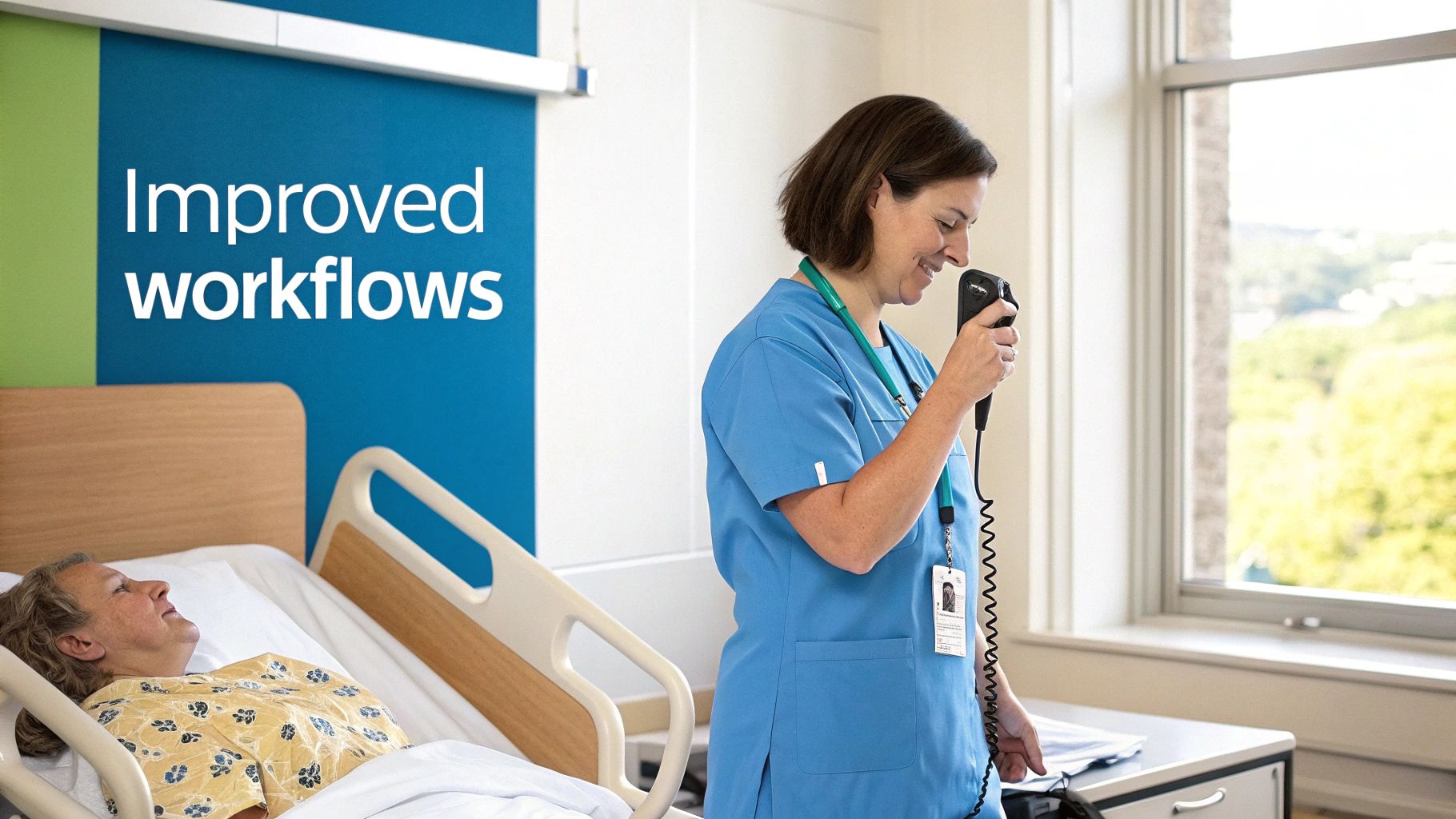A talking computer is a special tool that helps doctors. When a doctor talks, the computer writes down their words. Think of it like a helper that can type super fast.
This lets the doctor look at you, not at a computer screen. It saves the doctor a lot of time so they can focus on helping you feel better.
How a Talking Computer Helps Your Doctor
Imagine your doctor after a long day of seeing kids. Before, she had to sit and type for hours. She would write down everything she saw and did. It was slow and tiring. Sometimes, she might forget a small detail.
Now, that same doctor can just talk. While she checks your ears or listens to your heart, she speaks her notes into a small microphone. The computer listens and writes everything down right away.
This helps a lot. Writing notes that used to take hours now takes just a few minutes. That extra time means the doctor can spend more time talking with you and your family.
From Typing to Talking
When you go to the doctor, you want them to listen to you. You want them to look you in the eye. You don't want them to be busy typing. A talking computer makes this happen.
The best thing about a talking computer is it lets the doctor focus on the person, not the paperwork. It helps them be a better helper.
More and more doctors are using these talking tools. In 2024, people spent $2.1 billion on them. By 2037, they think people will spend $12.5 billion! This isn't just because it's faster. It's because it helps doctors from getting too tired and helps them write better notes about you.
Let's see how different it is.
Doctor's Notes: Old Way vs. New Way
| What They Do | The Old Way (Typing) | The New Way (Talking) |
|---|---|---|
| Taking Notes | The doctor types notes after you leave, trying to remember everything. | The doctor talks and the computer writes it down as it happens. |
| How Long It Takes | It can take 5-10 minutes for each person, which adds up to hours. | It takes about 1-2 minutes for each person. |
| Getting it Right | Typing fast can lead to mistakes or missed words. | It's very good at getting the doctor's words right. |
| Looking at You | The doctor has to look back and forth between you and the screen. | The doctor can keep their eyes on you the whole time. |
This table shows that a talking computer is a big change. It helps doctors do one of their longest jobs much faster. This means they can be better doctors for you.
This is more than just a cool tool. It helps make visiting the doctor a better, friendlier time. The same kind of tool that powers a voice recorder with transcription app on a phone is now helping save lives in hospitals.
How a Computer Learns to Understand a Doctor
How can a computer understand all those big doctor words? It seems like magic, but it's not. It's like teaching a kid a new language. You need to practice, use a dictionary, and learn from your mistakes. That's what a talking computer for doctors does.
It starts when a doctor talks into a microphone. The computer's brain, called AI, listens. But it doesn't try to hear the whole sentence at once. That would be too hard.
Instead, the computer breaks the doctor's voice into tiny little sounds. Each sound is like one letter in a word.
Making Words from Sounds
Once the computer has all the tiny sound pieces, it starts putting them together. It has a giant dictionary full of thousands of doctor words, like "tummy ache" or "temperature." The computer's job is to match the sounds it heard with the words in its dictionary.
It puts the sound pieces together very fast. When it hears the sounds for "tem-per-a-chur," it looks in its dictionary and builds the word "temperature." This all happens in a flash, turning talking into writing.
But the real magic is that the computer learns. The more a doctor uses it, the better it understands their voice.
A doctor's voice is like a fingerprint—everyone's is a little different. The computer learns how the doctor talks, how fast they talk, and their favorite words. This makes it better at writing down what they say.
This learning is what makes the computer a great helper. It gets better and better at making perfect notes for the doctor.
From Talking to a Patient's Chart
The path from when a doctor speaks to when the words are saved in your file is super fast. This picture shows how it works.


This shows how the computer does its work in the background without getting in the way. It's a straight line from the doctor's thought to your medical chart.
Of course, we always want the computer to understand better. You can learn more about what makes speech to text accuracy so good. The better the computer understands, the more it can help.
New computers are also great at working in noisy places. They can listen to the doctor's voice and ignore all the other sounds in a busy room.
This is important for a few reasons:
- Clear Notes: It only writes down what the doctor says, not people talking in the hall.
- Fewer Goofs: By focusing on one voice, the computer is less likely to get confused.
- Works Anywhere: A doctor can use it in a quiet office or a loud room and it still works great.
This smart listening helps create a perfect record of your visit. The computer isn't just hearing words; it's listening, learning, and becoming a better helper every day.
Real Examples of Talking Computers in Medicine
Talking computers are not a dream for the future. They are being used right now in hospitals and clinics every day. The best way to see how they help is to look at real doctors using them.
These are not made-up stories. They show how this tool is helping people right now.


Let's look at a few ways they are being used.
Helping Doctors Who Look at Pictures
Think of a doctor who looks at X-rays all day, like Dr. Chen. For every picture, he has to write a report about what he sees. Before, he had to look at the X-ray, then look at his keyboard, and type. It was slow and broke his focus.
Now, Dr. Chen's job is totally different because of his talking computer. While looking at an X-ray, he can just say what he sees. He might say, "The picture shows a small break in the arm bone," and the computer writes it down for him.
This one change lets him finish his reports three times faster. He can keep his eyes on the pictures and see every little detail. Because he is faster, other doctors get the reports sooner and can help their patients quicker.
Making a Nurse's Job Easier
Now, think about a nurse who visits people in their homes. She checks on them, gives them medicine, and sees how they are feeling. After each visit, she has to write down everything.
Before, she had to write notes by hand and then type them all up at the office. It took hours. With a talking computer, she can do it in minutes.
Using a tablet, she can speak her notes right after she sees a patient. By the time she leaves their house, the notes are all done. They are safe and ready for the whole medical team to see.
Getting notes done right away is very important. It means everyone helping a patient has the newest information. This helps stop mistakes and makes sure everyone gets the best care.
This is why so many places are using talking computers. People spent $30.5 billion on them in 2025. They think that number will grow to $62.9 billion by 2035 as more and more doctors start using them.
Helping in the Emergency Room
Nowhere is time more important than in the emergency room. Doctors there need to be fast. Their hands are busy helping people. Stopping to type on a computer can slow them down.
In the ER, a doctor can wear a small microphone and talk about a patient while still working. While checking someone, they can say what's wrong and what they are doing to help, all without stopping.
This means they can help someone breathe or give them medicine without pausing to type. The notes are right and written down as it happens, even when things are very busy. To learn more about how computers are helping doctors talk to patients, you can read about AI-powered healthcare communications.
How This Helps Doctors and You the Most
When a doctor stops typing and starts talking, it helps everyone. It's more than just being faster. It changes how a doctor can care for you. This tool doesn't just save a few minutes. It changes the feeling of the whole visit.
The biggest gift is time. The doctor is no longer trying to look at you and a computer screen at the same time. They can finally look up. This helps you trust them, talk more, and feel better cared for.
More Time for You
Think about your last time at the doctor. Did you watch them type a lot? Now, imagine they looked at you the whole time. A talking computer makes that happen.
By speaking their notes, doctors get back hours that they used to spend typing. That time now goes to patients, like you. They can answer one more question, explain things better, or just listen. A quick visit can turn into a real talk.
These tools help doctors fight all the paperwork. For example, in August 2024, a hospital called Northwestern Medicine got a system that turns talks with patients into notes all by itself. This saves tons of time and makes doctors less stressed. You can discover more insights about these solutions to see how much they help.
Writing a Better Story About You
A person can talk much faster than they can type. This is a big deal for doctor's notes. When a doctor speaks their notes, they can say more details than they could ever type.
Instead of just writing down that you have a cough, they can explain everything about it. They can tell the whole story of how you are feeling.
Better notes help doctors make better choices. When the whole team knows your full story, they can work together to give you the best care.
A spoken note is like a full chapter in your health story, not just a short sentence. It also means fewer typing mistakes, which makes everything safer for you.
Helping Doctors Feel Less Tired
A doctor's job is very hard. All the paperwork can make them feel very tired and stressed out. This is called burnout. When doctors feel this way, it's hard for them to give the best care.
By getting rid of hours of typing, talking computers help a lot. A doctor who is not so tired can use all their energy to help people get better. They can go home feeling happy about their work and ready for the next day.
This table shows how everyone is helped when a hospital uses this tool.
How a Talking Computer Helps Everyone
| Who It Helps | How It Helps Them |
|---|---|
| Doctors | They save time, feel less stressed, and can focus all their attention on you, not on typing. |
| Patients | You get more of your doctor's attention, feel like they are really listening, and your health records are better. |
| Hospitals | Everything runs better, patient charts are more complete, and care is safer for everyone. |
In the end, everyone wins. Doctors can be the great helpers they want to be, you get better care, and hospitals work better for everyone.
How Your Private Information Is Kept Safe
When a doctor talks to a computer about you, you might wonder, "Is my story safe?" Your health information is very private. Luckily, these talking computers are built to keep it super safe. Keeping your story safe is the most important part of using a talking computer in healthcare.
Think of it like this: when a doctor talks, their words turn into a secret file. The computer doesn't just put it in a folder. It locks it in a strong digital box that is almost impossible to open without a special key.


This digital box uses something called encryption. This mixes up the doctor's words into a secret code. If someone tried to look at it, it would just look like a bunch of nonsense. It's like turning a sentence into a mixed-up puzzle.
Keeping Secrets With a Digital Key
Only the right people, like your doctor or nurse, get the "secret key" to unlock the code and read the note. Without that key, the file stays locked. This keeps your private health story safe from others.
This happens every time a doctor speaks a note. It's a safety step that works in the background to make sure your story stays between you and your doctor's team.
Another safety step is used when your health info is used for science. To keep it private, all your personal information is removed first. A special PII redaction tool helps do this. It finds and takes out your name, address, and phone number so no one knows it's you.
The Rules Everyone Has to Follow
Besides the special tools, there are very strict rules for everyone who works with your health information. In the United States, the most important rule is called HIPAA.
Think of HIPAA as the official rulebook for that digital box. These rules are not just ideas—they are the law. They make sure everyone handles your private information with great care.
HIPAA makes sure that any company that sells talking computers to hospitals has the best security. They have to prove they are safe by passing special tests.
These laws give hospitals and you the trust to use these tools. Every part of the system is checked to make sure it follows these important rules.
How These Protections Work Together
It's not just one thing, but many layers of safety that keep your information protected. Here is how they all work together:
- The Digital Box (Encryption): Mixes up your information into a secret code so no one else can read it.
- The Secret Key (Access Controls): Makes sure only the right doctors and nurses with the right password can open and see your notes.
- The Rulebook (HIPAA Rules): The law that makes sure all health companies use the strongest safety tools to protect you.
This team of protections gives you peace of mind. It means that when your doctor uses a talking computer, your private health story stays safe and secret. The goal is always to give you better care while keeping your trust.
What's Next for Talking Computers in the Doctor's Office
So, what's next for this tool? Talking computers in healthcare are already great, but in the future, they will do more than just type. They will become smart helpers that work quietly to make every visit to the doctor better.
We are heading to a future where the computer doesn't just write down words—it understands what they mean. The goal is to make the tool so good that it does all the boring work for the doctor. This will let doctors be doctors.
A Helper That Thinks Ahead
Imagine this: you are talking to your doctor and say you need more of your medicine. Instead of the doctor stopping to type on the computer, the talking computer hears you. It gets the order for more medicine ready all by itself. All the doctor has to do is look at it and click "OK."
The same thing could happen for your next visit. The doctor might say, "Let's see you again in two weeks." The computer could hear that and show the doctor some open times for your next appointment. This kind of help lets the doctor keep their eyes and ears on you.
The big goal is to have a 'smart' doctor's office where the computer does all the background work. This will let doctors give 100% of their attention to the person right in front of them.
This change from a simple tool to a smart helper is happening in many places. You can see how smart voice AI agents are already changing how people do things in other jobs. The idea is the same—making hard jobs easier by listening and helping.
Helping People Who Speak Different Languages
Another amazing thing a talking computer could do is help people talk to each other. Soon, it could be a perfect translator in the doctor's office. This would mean a doctor who speaks English could talk to a patient who speaks Spanish. The computer would translate their words right away.
When the patient talks back in their language, the computer translates it for the doctor. This could break down walls between people who speak different languages. It would help every person feel heard and understood.
All of these new ideas for the future are about one thing: making healthcare more about people. By letting computers do the clicking and typing, we can put the focus back on listening, caring, and healing.
Common Questions About Talking Computers for Doctors
Even with all the good things, it's normal to have questions about how a talking computer for doctors works. People ask if it's hard to learn, if it makes mistakes, and if it takes jobs away. Let's answer some of those common questions.
Getting clear answers helps everyone see how this tool really helps in a busy clinic or hospital.
Is This Hard for Doctors to Learn?
Forget about the old, hard-to-use computer programs. Learning to use a new talking computer is very easy for doctors and nurses. Most are made to be as simple as talking to your phone.
It's usually very quick to get started. The real magic is how the computer gets smarter as it's used. It quickly learns how a doctor talks, their accent, and the doctor words they use the most.
The more a doctor uses the talking computer, the better it understands them. This means it gets better and faster every time, like a helper that learns to do its job perfectly.
This means the tool changes to fit the doctor, not the other way around.
Can the Computer Make a Mistake?
No tool is perfect all the time, but today's talking computers are very, very good. But there is always an important safety check: the doctor is always in charge. They have the final say on the note.
After the computer writes down what the doctor said, the doctor must read the whole note. They check it to make sure every word is right before they sign it. Only then does it become a part of your medical file.
This check is a rule that can't be skipped. Think of it like a pilot checking their plane before takeoff. It's a key step to keep you safe and make sure your health story is 100% correct.
Does This Replace People Who Type for Doctors?
This tool doesn't get rid of the people who type for doctors. It changes their job to be more about being an expert editor. Their job is now to be the last check for quality.
Many of these expert typists now use their knowledge of doctor words to make the computer's notes perfect. They are the human experts who make sure every note is exactly right.
They check for:
- Good Sentences: Making sure every sentence is written the right way.
- Clean Look: Making sure the note looks neat and is easy to read in your file.
- Correct Information: Using their knowledge to catch small mistakes the computer might have missed.
Their skills are more important than ever. They are the final keepers of quality for all talking computers in healthcare.
Ready to stop typing and start talking? WriteVoice can help you capture your thoughts up to four times faster. Learn how WriteVoice can transform your workflow today!
